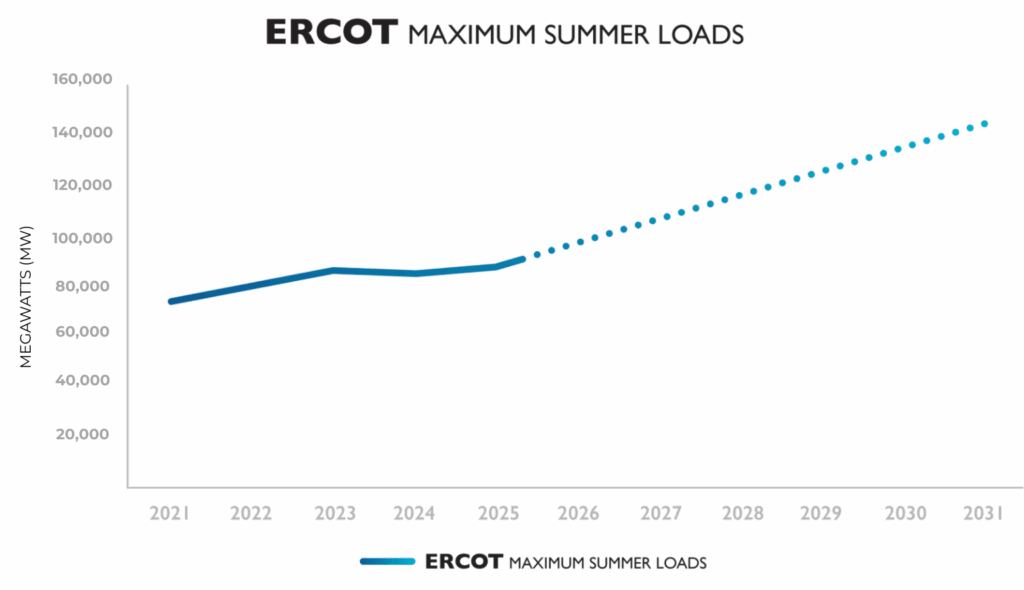We’re committed to providing reliable, clean energy to the Bastrop and Central Texas community while maintaining the highest environmental standards.
By adding modern gas turbines to the existing Bastrop Peaking Center, the proposed Bastrop Peaking Center will deliver significantly more reliable and clean energy without expanding the site’s footprint.
The project incorporates high-efficiency combustion technology, designed to meet growing energy demands responsibly and help prevent outages while using minimal water. Our comprehensive air quality analysis shows the local air will continue to be cleaner than National Ambient Air Quality Standards (NAAQS), which are set by the EPA to protect the health of vulnerable groups including people with asthma, elderly people, and children. We have applied for a Texas Commission on Environmental Quality (TCEQ) air permit and are committed to exceeding all applicable requirements, demonstrating our dedication to environmental stewardship beyond the standard regulatory expectations. We are committed to minimizing construction impacts on the local community, with construction traffic staying off neighborhood streets and construction activities following industry best practices for dust control and noise management.
Milepost Power, a sister company of Hull Street Energy whose employees have over 30 years of experience in the power sector, is developing the Bastrop Peaking Center project at the existing Bastrop Peaking Center site. This expansion will consist of six additional modern GE natural gas turbines, each capable of generating approximately 195 megawatts (MW) of clean electricity, providing up to 1,170 MW total capacity, enough to power approximately 234,000 homes during peak periods.
Milepost Power currently owns and operates approximately 3,600 MW of natural gas power plants across the US, including two facilities in Texas: the existing 617 MW Bastrop Peaking Center in Cedar Creek, and the 266 MW Paris Energy Center in Paris. The Bastrop Peaking Center builds on our proven track record of safe, reliable operations with excellent environmental performance.
The Bastrop Peaking Center is designed to start up fast and run during peak demand in any weather to keep the lights on for Texans year-round, helping to prevent another Winter Storm Uri or summer blackout. ERCOT, the state’s grid operator, predicts the state’s summer peak energy demand to increase by ~70% by 2031. According to recent ERCOT estimates, Texas has set record demand for electricity almost every year, and demand is projected to continue to rise due to population growth, industrial and manufacturing buildout, data centers, and extreme heat and cold seasons.
Unlike renewables and batteries, natural gas plants can turn on any time, in any weather, for as long as needed.


We’re committed to providing reliable, clean energy to the Bastrop and Central Texas community while maintaining the highest environmental standards.
By adding modern gas turbines to the existing Bastrop Energy Center, the proposed Bastrop Peaking Center will deliver significantly more reliable and clean energy without expanding the site’s footprint.
The project incorporates high-efficiency combustion technology, designed to meet growing energy demands responsibly and help prevent outages while using minimal water. Our comprehensive air quality analysis shows the local air will continue to be cleaner than National Ambient Air Quality Standards (NAAQS), which are set by the EPA to protect the health of vulnerable groups including people with asthma, elderly people, and children.
Peaker plants are power generation facilities designed to operate during periods of high electricity demand. Unlike baseload plants that run continuously, peakers provide power when the grid needs additional capacity, typically during hot summer afternoons and extreme weather events.
The existing Bastrop Energy Center site was selected to minimize community impact while maximizing grid benefits. The location has existing transmission infrastructure, appropriate zoning, and strategic positioning to serve the regional grid efficiently. The site perimeter, access roads, and water supply will not need to be expanded to accommodate the expansion. Construction activity will use the existing plant access road off of TX-71. As such, we do not anticipate traffic impact to local residents (Example: no trucks through neighborhoods).
Our comprehensive air quality analysis demonstrates that with the project online, local community air will continue to be better than National Ambient Air Quality Standards (NAAQS), which are set by the U.S. Environmental Protection Agency (EPA) to protect the health of vulnerable groups including people with asthma, elderly people, and children. We use the high-efficiency combustion technology from GE to minimize emissions, including low-NOx burners and advanced combustion controls. Additionally, our ozone analysis shows the project impact to local ozone concentration to be below the Significant Impact Level (SIL) set by the EPA, meaning the impact to the surrounding area’s ozone concentration is considered small and not meaningful by the EPA and TCEQ.
We use modern natural gas turbines with advanced emission controls, resulting in a design that passes TCEQ’s Best Available Control Technology (BACT) evaluation. This technology also allows the plant to start and stop quickly to only operate during peak demand periods, unlike many other power plants which have to run for extended periods of time to make sure they can be available for peak demand resulting in higher emissions. Some other plants also have to run on coal or diesel, which have higher emissions than natural gas.